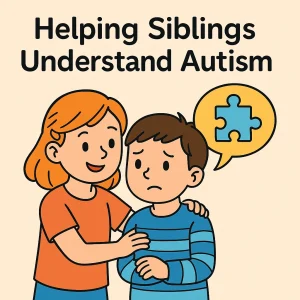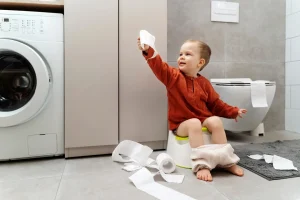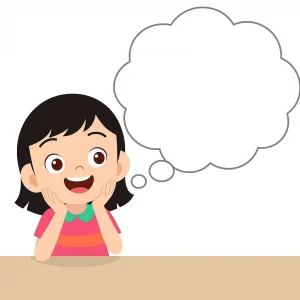How Does Dyspraxia Affect a Child’s Daily Life?
By Wellness Hub
Last Updated: April 5, 2025
Dyspraxia, also known as Developmental Coordination Disorder (DCD), is a common condition that affects motor coordination in children and adults. Though it’s estimated that dyspraxia affects around 6% of children to varying degrees, it often goes unrecognized. This neurological disorder impacts the planning and execution of sequences of movements required for everyday tasks, ranging from simple movements like waving goodbye to more complex tasks like tying shoelaces.
Understanding dyspraxia is crucial not only for the parents and educators of children living with this condition but also for the wider community. It’s about more than just the awkwardness that might be visible during physical activities; dyspraxia can also affect speech, perception, and thought. This makes comprehensive support and early diagnosis pivotal. By fostering an informed support network, we can significantly improve the daily experiences and developmental opportunities for children with dyspraxia.
Effects of Dyspraxia on Daily Life
Challenges in Motor Skills Development
Dyspraxia significantly impacts both fine and gross motor skills, which are essential for the majority of everyday activities. Fine motor skills, which involve smaller movements of the fingers, hands, and wrists, are crucial for tasks like writing, buttoning a shirt, or using utensils. Children with dyspraxia often find these tasks challenging, which can lead to frustration and a reluctance to engage in activities that require precise hand movements.
Gross motor skills, which include larger movements involving the arms, legs, or the entire body, are also affected. This can manifest as difficulty in coordination and balance, making physical activities such as running, jumping, or even walking up stairs more cumbersome than usual. The impact on these motor skills can make typical playground activities daunting and physically exhausting for children with dyspraxia.
Also read: 10 Key Signs of Dyspraxia in Children Parents Must Recognize
Dyspraxia and Learning Difficulties
When it comes to academic performance, dyspraxia can pose several challenges in the classroom. The disorder can affect a child’s ability to perform school tasks that require fine motor skills, such as writing neatly or using scissors. These challenges often result in slower task completion and difficulty following along with certain types of classroom activities, which can hinder academic progress.
Moreover, dyspraxia can affect a child’s organizational skills, making it hard to keep track of school assignments or manage their time efficiently. This can lead to further stress and anxiety, impacting their overall learning experience. Educators and parents must recognize these challenges to provide the necessary accommodations, like extra time for tests or the use of technology to aid in writing and note-taking.
Social and Emotional Consequences
The social and emotional impact of dyspraxia is profound. Children with dyspraxia may find it hard to participate in group activities or sports, which are often crucial for social development during childhood. This exclusion can lead to feelings of isolation and low self-esteem, as they might feel different from their peers.
Furthermore, the constant struggle with everyday tasks that others find simple can be discouraging and demoralizing, affecting their emotional health. It’s essential for caregivers and educators to provide a supportive environment that acknowledges their efforts and celebrates their successes, no matter how small. By fostering an inclusive community that understands and adapts to their needs, we can help boost their confidence and social skills.
Practical Solutions for Managing Dyspraxia
Educational Support and Adjustments
For children with dyspraxia, the traditional classroom setting can present numerous challenges. However, with thoughtful adjustments, educators and parents can significantly improve these children’s learning experiences. Here are some practical tips for adapting learning environments:
- Use of Assistive Technology: Incorporate tools such as typing programs or speech-to-text software to help with writing assignments, which can bypass difficulties with handwriting.
- Organizational Aids: Provide organizers or visual schedules to help children keep track of their tasks and responsibilities, reducing stress and enhancing their ability to focus.
- Tailored Instruction Methods: Employ teaching methods that accommodate various learning styles, such as using more hands-on activities for kinesthetic learners, which can help children with dyspraxia engage more fully with the material.
- Flexible Assessment Strategies: Offer alternative ways to assess knowledge, such as oral presentations or visual projects, instead of written tests, to allow students to demonstrate their understanding without the barrier of fine motor skill difficulties.
Therapeutic Approaches
Occupational and physical therapy are cornerstone treatments for managing dyspraxia, focusing on improving motor skills and enhancing daily functional abilities. Here’s an overview of what these therapies offer:
- Occupational Therapy (OT): OT helps children improve their fine motor skills and address challenges in daily activities at home and school. Occupational therapists work on skills like cutting with scissors, handwriting, and other precise tasks, tailoring activities to each child’s needs to promote independence.
- Physical Therapy (PT): This focuses on gross motor skills, such as walking, balance, and coordination. Physical therapists engage children in exercises that enhance muscle strength, coordination, and motor planning, making physical activities less daunting.
Home Strategies to Improve Motor Skills
Parents play a vital role in reinforcing therapeutic practices at home. Here are some simple exercises and activities that can help improve motor skills in children with dyspraxia:
- Obstacle Courses: Set up safe, fun obstacle courses at home that encourage crawling, stepping over objects, and moving in different directions. This can help improve spatial awareness and coordination.
- Craft Activities: Engage in arts and crafts that involve using scissors, glue sticks, and coloring pencils. These activities help enhance fine motor skills and hand-eye coordination.
- Ball Games: Simple games like catch or tossing a ball back and forth can improve hand-eye coordination and timing.
- Building Blocks and Puzzles: Activities that require stacking or assembling pieces can help develop problem-solving skills and fine motor precision.
Know more: Dyspraxia Explained: Impact & Strategies for Motor Skills
How Wellness Hub Helps Families Navigate Dyspraxia
Tailored Therapies and Resources
At Wellness Hub, we understand that each child with dyspraxia has unique needs and challenges. That’s why we offer a range of tailored therapies and resources designed specifically to support children with developmental coordination disorders. Our approach combines the latest research with practical, hands-on strategies to create effective treatment plans that cater to individual requirements.
- Customized Therapy Plans: Our specialized therapists work closely with each family to develop customized therapy plans that focus on the child’s specific areas of difficulty, whether it’s fine motor skills, gross motor coordination, or specific academic challenges.
- Interactive Tools and Apps: We provide access to innovative tools and apps that make learning and development fun and engaging. These resources use games and activities to practice motor skills, helping children to improve without the stress of traditional exercises.
- Resource Library: Wellness Hub offers a comprehensive library of resources, including instructional videos, step-by-step guides, and informative articles that empower parents and educators with the knowledge to support their children effectively.
Expert Guidance and Support
Wellness Hub prides itself on the expert guidance and support provided by our team of seasoned therapists and educational specialists. We are dedicated to helping families navigate the complexities of dyspraxia with confidence and knowledge.
- Access to Specialized Therapists: Our team includes highly trained occupational and physical therapists who specialize in pediatric developmental disorders. They are equipped with the skills and experience necessary to address the challenges associated with dyspraxia.
- Educational Workshops and Webinars: We regularly host workshops and webinars led by experts in child development and therapy. These sessions are designed to educate families about dyspraxia and provide practical tips for managing daily challenges.
- Personalized Support Sessions: Understanding that each family’s journey is different, we offer personalized support sessions. These meetings allow families to discuss their concerns and progress with a specialist, ensuring they receive the guidance needed to support their child effectively.
Conclusion
Dealing with dyspraxia can be tough, but at Wellness Hub, we’re here to help every step of the way. Our expert therapies, fun tools, and personalized support are designed to make life easier and more enjoyable for kids with dyspraxia and their families. We believe every child has incredible potential, and our resources are tailored to help them thrive. For more tips and support, check out our Page. Join us at Wellness Hub, where we turn challenges into achievements, making every child’s journey a success story. Let’s navigate this path together!
Frequently Asked Questions:
1. What is dyspraxia in children?
Dyspraxia, or Developmental Coordination Disorder, is a neurological disorder affecting physical coordination. It makes it hard for children to perform motor tasks and coordinate their movements properly, impacting activities like writing, getting dressed, or playing sports.
2. How can I tell if my child has dyspraxia?
Look for signs such as clumsiness, difficulty with fine motor skills (like buttoning a shirt or using scissors), challenges in learning new physical activities, and struggles with complex movements that require coordination.
3. What age can dyspraxia be diagnosed?
Dyspraxia is often diagnosed around the age of 5, but symptoms can appear earlier. Early signs might include delays in reaching motor development milestones like crawling or walking. A pediatrician or specialist can assess these symptoms to make a diagnosis.
4. Can dyspraxia affect a child’s learning?
Yes, dyspraxia can impact learning by making it difficult for children to perform school tasks that require motor skills and coordination, such as handwriting or using classroom tools. It can also affect their organizational skills, making it hard to keep track of school assignments.
5. What are the best therapies for children with dyspraxia?
Occupational therapy helps children develop the skills needed for daily tasks, improving fine motor skills and coordination. Physical therapy focuses on gross motor skills, helping with balance and movement. Both therapies are tailored to help children gain independence and confidence in their abilities.
6. Are there special schools for children with dyspraxia?
While there are no specific schools solely for dyspraxia, many educational institutions have support programs and resources tailored for children with various developmental challenges. These programs often include personalized learning plans and access to specialized therapists.
7. How can I help my child with dyspraxia at home?
Create a supportive environment that includes various motor skill-enhancing activities. Simple sports, arts and crafts, and board games that encourage hand-eye coordination are beneficial. Regular practice and positive reinforcement can help build your child’s skills and confidence.
8. Can children with dyspraxia play sports?
Children with dyspraxia can participate in sports, though they may need support and encouragement. Non-competitive sports that focus on participation and motor skills development, like swimming or cycling, might be particularly suitable.
9. Does dyspraxia get better as a child grows older?
Many children see improvements in their coordination and motor skills with appropriate therapy and support. However, some may continue to experience challenges into adulthood. Ongoing support and adaptation strategies are important.
10. Where can I find more resources and support for dyspraxia?
For comprehensive resources, support options, and expert advice on managing dyspraxia, visit Wellness Hub’s Dyspraxia Resource Page. You’ll find a range of helpful materials and information designed to assist parents and caregivers.
About the Author:
Rajini Darugupally
M.Sc., Speech-Language Pathologist (9+ years of experience)
Rajini is a passionate and dedicated Speech-Language Pathologist with over 9+ years of experience, specializing in both developmental speech and language disorders in children and rehabilitation in adults. Driven by a desire to empower each individual to find their voice, Rajini brings a wealth of experience and a warm, genuine approach to therapy. Currently, at Wellness Hub, she thrives in a team environment that values innovation, compassion, and achieving results for their clients.
Book your Free Consultation Today
Parent/Caregiver Info:
Client’s Details:
* Error Message









